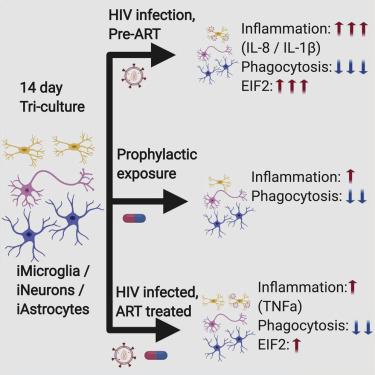Stem Cell Reports ( IF 5.9 ) Pub Date : 2020-03-26 , DOI: 10.1016/j.stemcr.2020.02.010 Sean K Ryan 1 , Michael V Gonzalez 2 , James P Garifallou 2 , Frederick C Bennett 3 , Kimberly S Williams 4 , Nathaniel P Sotuyo 5 , Eugene Mironets 6 , Kieona Cook 5 , Hakon Hakonarson 7 , Stewart A Anderson 8 , Kelly L Jordan-Sciutto 9

|
HIV-associated neurocognitive disorders (HAND) affect over half of HIV-infected individuals, despite antiretroviral therapy (ART). Therapeutically targetable mechanisms underlying HAND remain elusive, partly due to a lack of a representative model. We developed a human-induced pluripotent stem cell (hiPSC)-based model, independently differentiating hiPSCs into neurons, astrocytes, and microglia, and systematically combining to generate a tri-culture with or without HIV infection and ART. Single-cell RNA sequencing analysis on tri-cultures with HIV-infected microglia revealed inflammatory signatures in the microglia and EIF2 signaling in all three cell types. Treatment with the antiretroviral compound efavirenz (EFZ) mostly resolved these signatures. However, EFZ increased RhoGDI and CD40 signaling in the HIV-infected microglia. This activation was associated with a persistent increase in tumor necrosis factor α production by microglia. This work establishes a tri-culture that recapitulates key features of HIV infection in the CNS and provides a new model to examine the effects of infection, its treatment, and other co-morbid conditions.
中文翻译:

尽管在HIV感染的hiPSC三培养模型中进行了抗逆转录病毒治疗,但神经炎症和EIF2信号仍然持续存在。
尽管有抗逆转录病毒疗法(ART),但与HIV相关的神经认知障碍(HAND)仍会影响超过一半的HIV感染者。HAND基础的可治疗性靶向机制仍然难以捉摸,部分原因是缺乏代表性模型。我们开发了一种基于人诱导的多能干细胞(hiPSC)的模型,将hiPSC独立区分为神经元,星形胶质细胞和小胶质细胞,并系统组合以生成带有或不带有HIV感染和ART的三培养。用HIV感染的小胶质细胞进行三培养的单细胞RNA测序分析显示,在所有三种细胞类型中,小胶质细胞中有炎症信号和EIF2信号传导。抗逆转录病毒药物依非韦伦(EFZ)的治疗大多可以解决这些症状。但是,EFZ增加了HIV感染的小胶质细胞的RhoGDI和CD40信号传导。这种激活与小胶质细胞产生的肿瘤坏死因子α持续增加有关。这项工作建立了三种文化,概括了中枢神经系统中HIV感染的关键特征,并提供了一种新模型来检查感染的影响,其治疗和其他合并症。


























 京公网安备 11010802027423号
京公网安备 11010802027423号